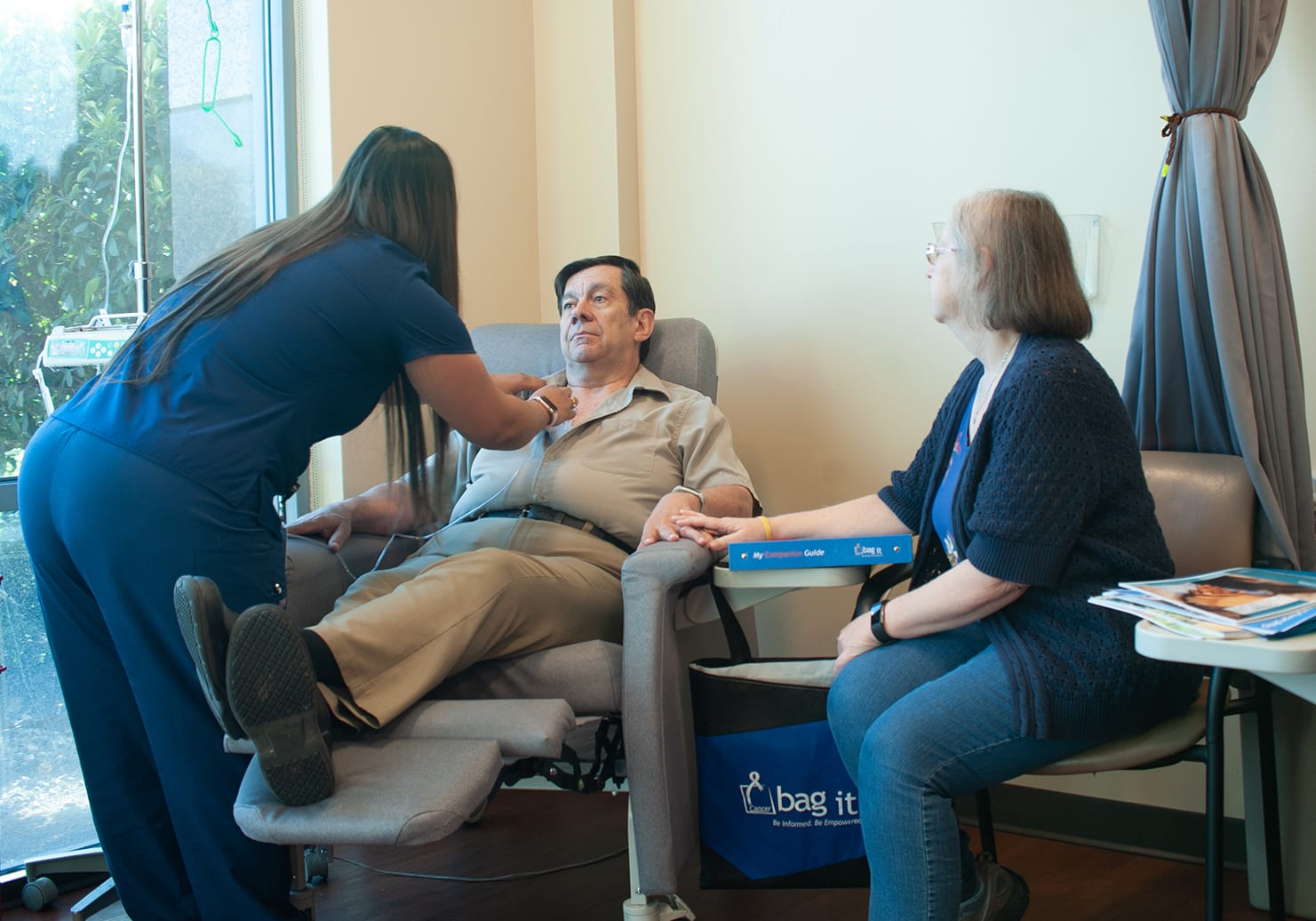Cancer Caregivers
Caregivers are friends and family members giving care to a person with cancer. A caregiver may help with daily activities, coordinate care and services or offer emotional support.
Bag It Bag Resources for Caregivers
The Bag It bag includes resources specifically to support those who are providing care and support for cancer patients. Among our resources, we’ve included Caring for the Caregiver, from the National Cancer Institute. This booklet offers ways for a friend or family member to take care of themselves while caring for a loved one with cancer. This booklet covers topics that include:
• Understanding your feelings and asking for help
• How to make time for yourself
• Caring for your body and spirit
• Going with your loved one to medical visits
• Talking with friends and family members about cancer
Visit the NCI Caring for the Caregiver page in order to download and share this resource.

Caregiving Across the Miles
A long-distance caregiver lives an hour or more away from someone who needs care. Your support could take many forms such as connecting by phone, texts, emails and virtual visits, doing research, navigating insurance or finances online, managing the household from afar, coordinating in home care or services, visiting to relieve a primary caregiver, keeping extended family and friends in the communication loop, or even helping with expenses. Even if you can’t be there in person, your role is important and there is much you can do for your loved one no matter where you live.
Whether you are a new caregiver or have been in this role for some time, these suggestions can make life a little easier for everyone.

Tips for Getting Started
- Learn about your loved one’s specific cancer type (and/or other diseases), their medications and their treatments. This will help you to anticipate what to expect, enable you to communicate knowledgeably with your loved one, other caregivers, and the healthcare team, as well as assist in future decision making. Before hopping on to Dr. Google check out these tips on how to do research safely online and evaluate the credibility of the websites you source. The Resource Center on the Bag it website features a list of resources for every cancer type and any cancer topic.
- Ask your loved one and any other caregiver(s) what you can do to help. Communicating long-distance, even with text and email, is not the same as being there and can be even more challenging. It’s important that conversations are frank and clear. Actively listen to their stated needs and preferences and follow up with questions to be sure you understand. Together, create a checklist of what needs to be done (click here for examples). Be flexible. Keep in mind that your loved one’s condition will change and adaptations will be necessary as time goes by.
- Build a team of caregivers if it does not already exist. Take into account what everyone’s individual strengths, interests and limitations are when coordinating who will do what, from where and when. Your loved one should be a part of this important process, if possible.
- Get organized. Bag It’s My Companion Guidebook is a perfect tool to keep everything in order and in one place. Use it to store medical
 info, health care and personal contacts, reports/scans/labs, calendar items, insurance info, notes and questions for the doctor, track side effects and symptoms, and much more. The handy forms can be filled in by hand or use the fillable PDF format to print, save and update later, and share electronically with others as you see fit. Find the forms here. Maintaining this information and all the paperwork on an ongoing basis will make this an easy go to reference for caregivers and doctor visits alike.
info, health care and personal contacts, reports/scans/labs, calendar items, insurance info, notes and questions for the doctor, track side effects and symptoms, and much more. The handy forms can be filled in by hand or use the fillable PDF format to print, save and update later, and share electronically with others as you see fit. Find the forms here. Maintaining this information and all the paperwork on an ongoing basis will make this an easy go to reference for caregivers and doctor visits alike. - Offer to join your loved one’s doctor appointments virtually. The pandemic has greatly expanded the ability for health care systems to easily include caregivers by phone or video conferencing during in-person or virtual office visits.
- Gather information about local resources where your loved one lives. Programs and services that assist with in-home care, meals, medical equipment and aides, transportation and other needs may be available to fill some gaps or ease caregiving responsibilities of a primary caregiver.
- Being a long-distance caregiver brings its own unique challenges, stress and other emotions, particularly when for an extended period of time. Have your own support system in place and connect with people who understand what you are going through. This could be a caregiver support group, online community, a counselor or even a friend who has also been a caregiver.
Tips for Long-Distance Caregivers
- Consider a medical alert system if there is not a caregiver in the home at all times.
- New to caregiving? Consider attending caregiving training available through your local aging agency, AARP or other business in your local community or online. This specialized training can include helpful skills such as first aid, physical care and safety, assisting with activities of daily living, and other ways that you can be an effective caregiver in person or from afar.
- As a caregiver you may be eligible to take unpaid leave from your job to care for a family member under the Family and Medical Leave Act (“FMLA”). Learn about your rights here and check with your employer regarding potential coverage and FMLA policies related to your job.
- Check this list of APPs available to help manage many aspects of caregiving.
- Pack a travel bag in advance and prepare your own household in the event you need to leave quickly for a few days to attend your loved one.
Helpful Tips for When You Visit Your Loved One
- Plan your visit to identify what you want to assess and what you hope to accomplish from a practical standpoint, but don’t forget to also set aside dedicated time to enjoy each other’s company. Do things that are fun and relaxing that are not focused on caregiving or a “to do” list. (These hours could be the ideal time to give the primary caregiver a much-needed respite for a few hours or day or two if you can swing it.)
- If possible, accompany your loved one to their in-person doctor appointment. Use the Bag It form My Appointment Summary Log form to
 note the appointment details and write down the questions to be asked (and answers received).
note the appointment details and write down the questions to be asked (and answers received). - During the appointment, get your loved one’s permission to allow the healthcare team to share medical information with you and get the necessary paperwork signed along with a copy for yourself. Exchange your contact info with the health care team and discuss the best method for future communication together.
- Hold a meeting with your family/caregivers. You bring a fresh perspective and may observe things that a primary caregiver does not notice day-to-day. Continue to listen carefully and be aware that other caregivers are also under tremendous pressure so emotions can run high. If you offer suggestions for more help, be specific about the types of support you are proposing. For example, having a home health aide come in each week, hiring help with yard work or other household maintenance, having groceries or prepared meals delivered, or arranging for transportation for medical appointments.
- If not already completed, start the conversations with your loved one and the other appropriate people to have a healthcare power of attorney and a durable power of attorney completed in the event your loved one becomes unable to speak or make decisions for themselves. While these topics can be sensitive and more than one discussion may be needed, executing these documents ensures that your loved one’s wishes will be followed. Advance health care directives are also a tremendous help for the medical team and others potentially making decisions on your loved one’s behalf if needed in the future.
- Take care of yourself during visits to your loved one. Get plenty of rest and set aside some time to recharge so you can be your best self with them. Remember you will not solve all the problems and have all the answers but your support, assistance and presence will no doubt mean a great deal to those you care about.
Additional Resources for Caregivers & Family
Caring for the Caregiver from the National Cancer Institute
Lotsa Helping Hands – Organize meals and help for someone in need.
Help for Cancer Caregivers – Personal caregiver guide.
Take Them A Meal – Online meal coordination tool.
Family Caregiver Alliance – Caregiver education, online support groups.
National Family Caregivers Association – Tips and videos about caregiving.
Pearlpoint – Caregiving tips, nutrition, caregiver handbook.
Patient Power’s Care Partner Center
EduMed – The Caregiver’s Handbook.
College Consultants Care – College application & financial assistance
Jack’s Caregiver Coalition – Improving the way guys think, feel, and act through every phase of their caregiving journey.
Caregiving Across the Miles
Download PDFs, ebooks, or Kindle versions
When Someone You Love Is Being Treated for Cancer – Support for Caregivers
When Your Parent Has Cancer – A Guide For Teens
When Someone You Love Has Advanced Cancer: Support for Caregivers
Facing Forward When Someone You Love Has Completed Cancer Treatment – Support for Caregivers
Please visit our comprehensive Bag It Resource Center for additional family resources, including information on Parenting & Fertility.
